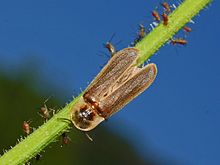Lampyris noctiluca
| Lampyris noctiluca | |
|---|---|
 |
|
| Male | |
 |
|
| Left: Adult female Right: same animal emitting light |
|
| Scientific classification | |
| Kingdom: | Animalia |
| Phylum: | Arthropoda |
| Class: | Insecta |
| Order: | Coleoptera |
| Family: | Lampyridae |
| Genus: | Lampyris |
| Species: | L. noctiluca |
| Binomial name | |
|
Lampyris noctiluca (Linnaeus, 1767) |
|
| Synonyms | |
|
Cantharis noctiluca Linnaeus, 1767 Lampyris minor Olivier, 1901 |
|
Cantharis noctiluca Linnaeus, 1767
Lampyris bellieri Reiche, 1858
Lampyris carreti Olivier, 1895
Lampyris longipennis Motschulsky, 1853
Lampyris minor Olivier, 1901
Lampyris obscurella Motschulsky, 1853
Lampyris parvicollis Olivier, 1901
Lampyris sibirica Gebler, 1847
Lampyris submucronata Rey, 1891
Lampyris thoracica Motschulsky, 1853
Lampyris noctiluca, the common glow-worm of Europe (see also "glowworm"), is a firefly species of the genus Lampyris. These are beetles, as evidenced by the hard cases which close over the wings when they are not in use.
Lampyris noctiluca presents a conspicuous sexual dimorphism. The males are winged, with brown elytra, a clearer pronotum and a large brown spot in the middle, while females are larviforme, wings are missing and they are often twice the size of the males (up to 25 millimetres or 1 inch in length).
These beetles use their bioluminescence to attract mates. The adult females are mostly famed for their glow, although all stages of their life cycle are capable of glowing.
In Britain, this species is fairly common compared to its cousin Phosphaenus hemipterus – the lesser glow worm – which is very rare.
The range of this beetle stretches from Portugal and Britain in the west, right across Europe and Asia to China in the east. It also survives further north than any other firefly, almost reaching the Arctic Circle. It is not found in North or South America.
Light production is vital for Lampyris noctiluca. With it they have greater chances of mating, so there is a complex process involved.
They emit yellowish-green light from the translucent underside of their last three abdominal segments to attract the smaller males, which are winged. They will glow for 2 hours and then retreat back into their hiding place until the next night, or stop glowing as soon as they find a mate. The females can survive up to 10 consecutive nights doing this.
...
Wikipedia
